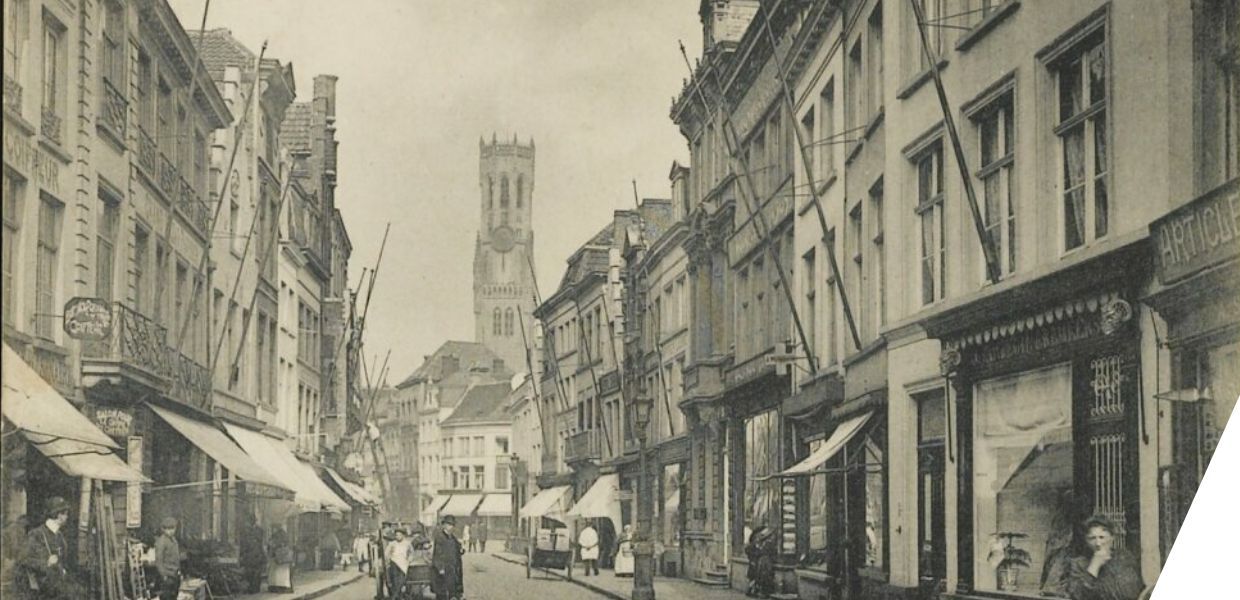Since the end of November 2023, visitors to Europeana.eu have been able to explore nostalgic black and white images of Bruges, the city that Georges Rodenbach described in his famous 1892 novel Bruges-la-Morte. They include well-known buildings such as the Belfry, St. John’s Hospital and the city gates, but also iconic buildings that have since been demolished (such as Bruges’ first railway stations). The women at the fish market, the people posing in front of their houses, the soldiers at their barracks, and the milk peddlers and coal merchants walking along the streets remind us that Bruges was a lively city in the 19th century.
Digital without borders
The first steps that we took to make these images available on Europeana.eu were taken from 2019 - 2021 under the project ‘Grenzeloos digitaal: internationale ontsluiting en meertalige doorzoekbaarheid van data uit erfgoedbrugge.be’ (‘digital without borders: international access and multilingual searchability of data from erfgoedbrugge.be’). The project examined how we could make data about heritage collections from Bruges more accessible for international audiences, and was funded by the Flemish Government. We were motivated to see how we could better share our digitised heritage collections with the millions of visitors that the city receives every year, or with people that are interested in the city's history, but can't read Dutch.
One of the collections we examined was the huge photograph collection of the City Archives (over 100,000 images). Through a collaboration with the Europeana aggregator Photoconsortium, we explored the possibility of presenting a selection of the photographs on Europeana.eu, using the MINT mapping tool to convert our source metadata schema to the Europeana Data Model.
Metadata, rights statements and persistent URLs
The first tests, realised in close collaboration with Photoconsortium, indicated that the metadata of the collection fulfilled the requirements to share the data with Europeana.eu, but we identified two obstacles too: the absence of a copyright status for each image and permanent URLs.
After the end of the ‘Grenzeloos digitaal’ project, we continued to develop a feasible method to determine the copyright status of our images. This resulted in a set of images which we are certain belong to the public domain, and these images could therefore be presented on Europeana.eu. Find out more about how to identify and clear copyright in collection items.
Finally, we also found a solution for the URLs. Through our collection management system, we could provide permanent URLs that give access to the images. A direct URL to the detail pages on our own portal still proved impossible. For that reason, we choose to provide a generic URL that links to a page with more information about the photograph collection. This URL is shown on each Europeana item page when you select ‘View on the providing institution's website’.
With the completion of the dataset, now including a proper rights label and the direct URLs to the images, several tests with the METIS Sandbox were performed by Photoconsortium, to anticipate the results and verify in preview how the collections would appear on Europeana.eu. Eventually, the harvesting and publication phases by the Europeana Data Publishing Services Team allowed the collection to be made available on Europeana.eu
Translations
The project also examined if the titles and descriptions of the photographs could be translated into English and French using machine translation. Several tests with Google and Amazon translation services led to relatively good results, but the quality of the translations was insufficient to publish them online without manual validation. This method ultimately proved too labour-intensive for larger numbers of photographs. For the field Type of item (dc:type) we decided to work with the Art & Architecture Thesaurus (AAT). We provided an AAT URI for each value in this field. On Europeana.eu these values (e.g. ‘picture postcards’) are now shown in Dutch, English, French and Spanish, depending on the language someone chooses.
Find out more
You can discover the collection on Europeana.eu, or, if you would like to follow in our footsteps, discover how to share your data with Europeana.eu.


